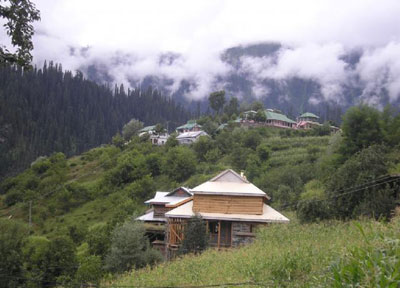 What
What people thought was an impressive front of our house was actually its mediocre back that had this Magam-Pattan road running parallel to it. The front was far more imposing. It had a huge dub – balcony running end-to-end, the frames of which contained superb woodwork interlocked through medium-sized hexagonal holes. Birds found way through these holes, had a gliding voyage of all rooms, stopped over in the kitchen for a bathfol – a grain of cooked rice and made a smooth exit through what appeared to be a dub-gone-wrong at the back of the house.
The house opened into a huge courtyard, then a kocha – a street, a few more houses and then this Nallah Ferozpura tributary. While the whole town and unknown number of villages passed by the kitchen through the day, least did we realize that many glaciers were melting into the river in the meanwhile.
In the whole village this house had assumed an envious T-shape which, father would say, had resulted on account of combined demaag lagavun – application of mind by him and local wasta – the carpenter. Wasta was the architect; architects, if there were any, were a passé. Wasta was on immediate call for a mashwara – guidance, if father decided to fix a nail in a garvang – the traditional cabinet or extract one from staircase that he thought exposed children to a cut or a bruise.
Most of this architectural acumen that wasta had acquired was by way of experimenting on this house. “He has been working on this house since I was your age,” father once said and added,
“aem huoch yeti – he learned carpentry working on this house only”.
For us, wasta was a great craftsman, a great carpenter, who was father’s best buddy. Whenever he would be around, we would expect a new development at home. He would take no time erecting a solid structure on just two angles. He had built the kitchen the same way – it took us long to understand why our kanipethuk kitchen – kitchen at the top floor stood ejected out of the main frame.
May be both wasta and father had thought of making a dub first, but had a change of thought later. That is probably why it was all made of wood, the floor and some portion of the sides of bricks and clay so that dhaan – the traditional oven could be accommodated. There was risk of fire otherwise.
The kitchen had a sitting area, where we would watch mother make
tomla tch’ot – roti from rice flour or eat one garam-garam – hot on spot. Whenever the Tangmarg-Baramulla service or a truck carrying load would pass by, the kitchen would shake in a way it would during an earthquake.
“Tchyiv se savair – take a ride”, mother would quip as she turned yet another roti to bake.
“Bunil aav – it is an earthquake,” the younger sister, who had a humorous bent of mind, would pun.
“Wuni chu gachaan – it is still happening”, she would continue until the tremors ebbed as the vehicle got a distance away.
Since tremors would be felt throughout the house, father would feel them elsewhere. While building the house brick by brick on a strong foundation of ancestors, he had expected it to be a peaceful dwelling rather than a wobbling one. The wobbling house seemed to worry him as much as a shaky kitchen elated us.
“Ask wasta nazra dein – tell wasta to come over”, he once told me, appearing relatively uneasy.
The same evening as wasta was leaving our house; he held me at the entrance and said,
“Hyo, moel che setha pareshan – your father is greatly worried, and added, “He doesn’t know this house is made up of just wood and nails – three quintals of nails to be precise.
Hilli na te adkya – if it wouldn’t shake, what would it?”
Contribution by Dr Sanjay Parva:
Dr Sanjay Parva is a Kashmir-born author, poet and columnist. Like other 400 thousand Kashmiri Pandits who were forced to leave Kashmir in 1990 as a part of a sinister plan of ethnic cleansing, Dr Parva’s family too had to flee the Valley following armed insurgency. A recipient of P N Bhat Award for Amateur Journalism, his book Words About to Fall will be out shortly and another book on Kashmir early next year. The piece above is one of many pieces on his home nostalgia, published as part of Musings, a popular column by him that he writes for Greater Kashmir, Valley’s best-selling newspaper, published from Srinagar. He can be reached at iknowparva@gmail.com or facebook.com/sanjay.parva
 What people thought was an impressive front of our house was actually its mediocre back that had this Magam-Pattan road running parallel to it. The front was far more imposing. It had a huge dub – balcony running end-to-end, the frames of which contained superb woodwork interlocked through medium-sized hexagonal holes. Birds found way through these holes, had a gliding voyage of all rooms, stopped over in the kitchen for a bathfol – a grain of cooked rice and made a smooth exit through what appeared to be a dub-gone-wrong at the back of the house.
What people thought was an impressive front of our house was actually its mediocre back that had this Magam-Pattan road running parallel to it. The front was far more imposing. It had a huge dub – balcony running end-to-end, the frames of which contained superb woodwork interlocked through medium-sized hexagonal holes. Birds found way through these holes, had a gliding voyage of all rooms, stopped over in the kitchen for a bathfol – a grain of cooked rice and made a smooth exit through what appeared to be a dub-gone-wrong at the back of the house.